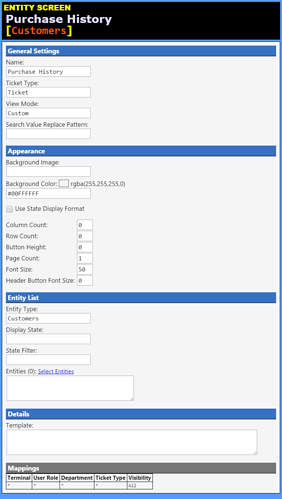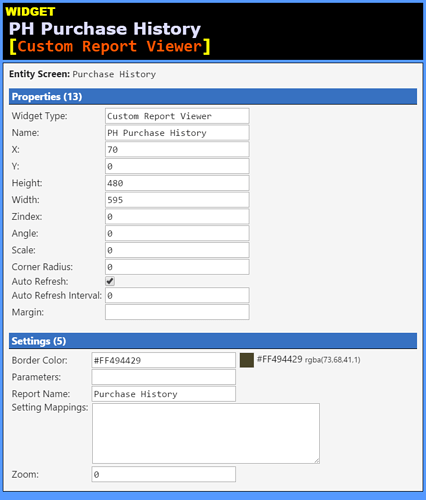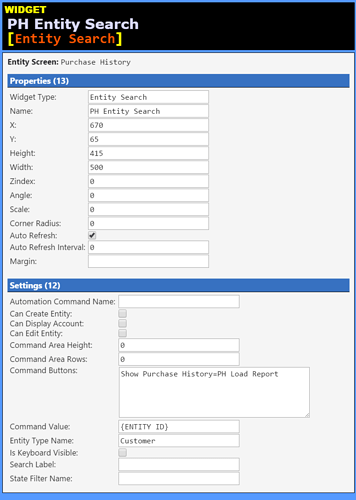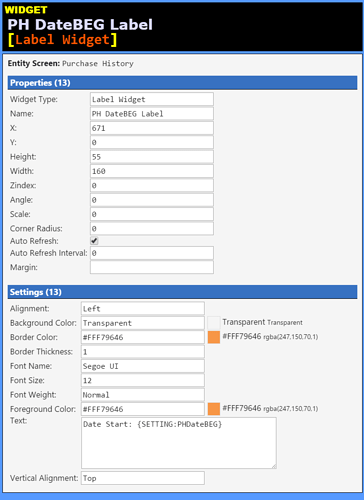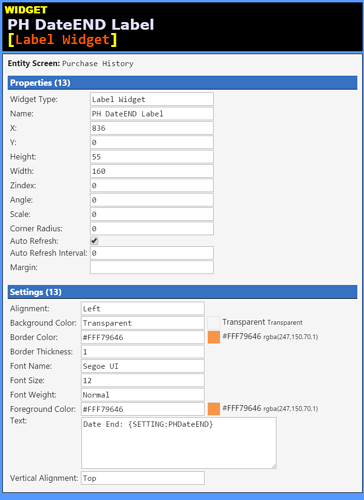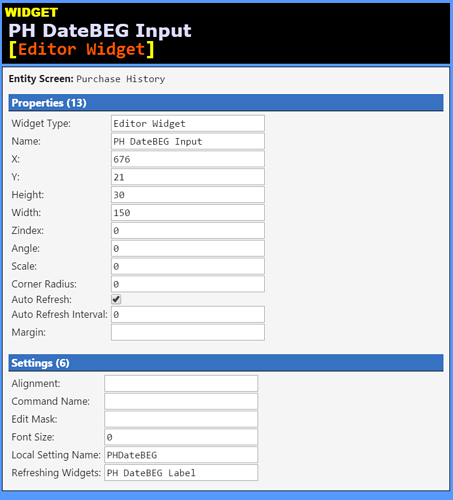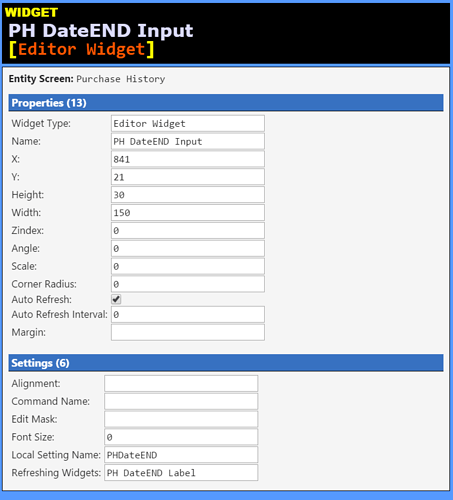#Entity Screen - definition
##Purchase History
[Customers](Entity Screen)##
| Name: | Purchase History |
| Ticket Type: | Ticket |
| View Mode: | Custom |
| Search Value Replace Pattern: | |
Appearance
| Background Image: | |
| Background Color: | #00FFFFFF |
| Use State Display Format: | unchecked |
| Column Count: | 0 |
| Row Count: | 0 |
| Button Height: | 0 |
| Page Count: | 1 |
| Font Size: | 50 |
| Header Button Font Size: | 0 |
Entity List (0)
| Entity Type: | Customers |
| Display State: | |
| State Filter: | |
Details Template (none)
(none)Mappings (1)
| Terminal | User Role | Department | Ticket Type | Visibility |
* | * | * | * | All |
#Entity Screen - Widgets
##PH Purchase History
[Custom Report Viewer](Widget)##
Entity Screen:Purchase History
###Properties (13):###
| Widget Type: | Custom Report Viewer |
| Name: | PH Purchase History |
| X: | 70 |
| Y: | 0 |
| Height: | 480 |
| Width: | 595 |
| Zindex: | 0 |
| Angle: | 0 |
| Scale: | 0 |
| Corner Radius: | 0 |
| Auto Refresh: | checked |
| Auto Refresh Interval: | 0 |
| Margin: | |
###Settings (5):###
| Border Color: | #FF494429 |
| Parameters: | |
| Report Name: | Purchase History |
| Setting Mappings: | |
| Zoom: | 0 |
##PH Entity Search
[Entity Search](Widget)##
Entity Screen:Purchase History
###Properties (13):###
| Widget Type: | Entity Search |
| Name: | PH Entity Search |
| X: | 670 |
| Y: | 65 |
| Height: | 415 |
| Width: | 500 |
| Zindex: | 0 |
| Angle: | 0 |
| Scale: | 0 |
| Corner Radius: | 0 |
| Auto Refresh: | checked |
| Auto Refresh Interval: | 0 |
| Margin: | |
###Settings (12):###
| Automation Command Name: | |
| Can Create Entity: | unchecked |
| Can Display Account: | unchecked |
| Can Edit Entity: | unchecked |
| Command Area Height: | 0 |
| Command Area Rows: | 0 |
| Command Buttons: | Show Purchase History=PH Load Report |
| Command Value: | {ENTITY ID} |
| Entity Type Name: | Customer |
| Is Keyboard Visible: | unchecked |
| Search Label: | |
| State Filter Name: | |
##PH DateBEG Label
[Label Widget](Widget)##
Entity Screen:Purchase History
###Properties (13):###
| Widget Type: | Label Widget |
| Name: | PH DateBEG Label |
| X: | 671 |
| Y: | 0 |
| Height: | 55 |
| Width: | 160 |
| Zindex: | 0 |
| Angle: | 0 |
| Scale: | 0 |
| Corner Radius: | 0 |
| Auto Refresh: | checked |
| Auto Refresh Interval: | 0 |
| Margin: | |
###Settings (13):###
| Alignment: | Left |
| Background Color: | Transparent |
| Border Color: | #FFF79646 |
| Border Thickness: | 1 |
| Font Name: | Segoe UI |
| Font Size: | 12 |
| Font Weight: | Normal |
| Foreground Color: | #FFF79646 |
| Text: | Date Start: {SETTING:PHDateBEG} |
| Vertical Alignment: | Top |
##PH DateEND Label
[Label Widget](Widget)##
Entity Screen:Purchase History
###Properties (13):###
| Widget Type: | Label Widget |
| Name: | PH DateEND Label |
| X: | 836 |
| Y: | 0 |
| Height: | 55 |
| Width: | 160 |
| Zindex: | 0 |
| Angle: | 0 |
| Scale: | 0 |
| Corner Radius: | 0 |
| Auto Refresh: | checked |
| Auto Refresh Interval: | 0 |
| Margin: | |
###Settings (13):###
| Alignment: | Left |
| Background Color: | Transparent |
| Border Color: | #FFF79646 |
| Border Thickness: | 1 |
| Font Name: | Segoe UI |
| Font Size: | 12 |
| Font Weight: | Normal |
| Foreground Color: | #FFF79646 |
| Text: | Date End: {SETTING:PHDateEND} |
| Vertical Alignment: | Top |
##PH DateBEG Input
[Editor Widget](Widget)##
Entity Screen:Purchase History
###Properties (13):###
| Widget Type: | Editor Widget |
| Name: | PH DateBEG Input |
| X: | 676 |
| Y: | 21 |
| Height: | 30 |
| Width: | 150 |
| Zindex: | 5 |
| Angle: | 0 |
| Scale: | 0 |
| Corner Radius: | 0 |
| Auto Refresh: | checked |
| Auto Refresh Interval: | 0 |
| Margin: | |
###Settings (6):###
| Alignment: | |
| Command Name: | |
| Edit Mask: | |
| Font Size: | 0 |
| Local Setting Name: | PHDateBEG |
| Refreshing Widgets: | PH DateBEG Label |
##PH DateEND Input
[Editor Widget](Widget)##
Entity Screen:Purchase History
###Properties (13):###
| Widget Type: | Editor Widget |
| Name: | PH DateEND Input |
| X: | 841 |
| Y: | 21 |
| Height: | 30 |
| Width: | 150 |
| Zindex: | 5 |
| Angle: | 0 |
| Scale: | 0 |
| Corner Radius: | 0 |
| Auto Refresh: | checked |
| Auto Refresh Interval: | 0 |
| Margin: | |
###Settings (6):###
| Alignment: | |
| Command Name: | |
| Edit Mask: | |
| Font Size: | 0 |
| Local Setting Name: | PHDateEND |
| Refreshing Widgets: | PH DateEND Label |
